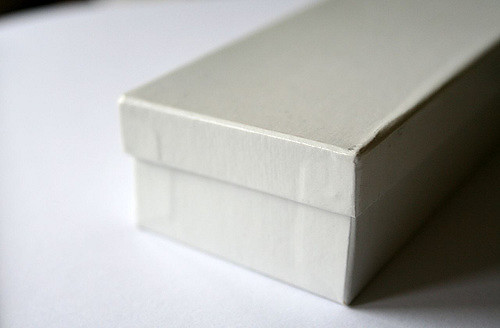2018 Theme Issue: Keepsakes

Why not keep whatever remains of love?
In my bedroom there is a bright blue plastic bin that holds the ashes of five dogs: Kobi, Pearl, Fergus, Porter, and Nio, a motley crew of strays and throwaways who arrived in my life one by one, always unexpected but, in retrospect, clearly fated to be mine. Each departed pup is housed in a neat white box, the kind you might expect to contain arty tchotchkes or Christmas ornaments. If not for the crematory labels noting the name and death date of each dog, you could easily mistake my pals for a stockpile of hostess gifts.
The ashes haven’t always rested in the plastic bin. For several years, three dogs lived in the bottom drawer of a handsome oak dresser, along with a cache of love letters from my ex-husband. I say “lived” because that’s how I generally think of the situation: Though released from their mortal dogginess to a more elemental state of being, my pets still exist in my mind as their breathing, drooling, bright-eyed selves. The love letters live for me, too, with a shimmering clarity of unforgotten feeling, even though the husband who wrote them is long gone and his love has been gone even longer.
The dignified arrangement in the dresser ended after the fourth dog, Porter, died in the spring of 2016. Porter was a plucky, starving little Feist mix I picked up on the road one morning. He sat down in front of my approaching car and simply refused to move, so I took him home. Attempts to find his owner failed, and I soon accepted that I had been successfully recruited for the job.
Already an old dog when I found him, Porter lived with me for seven years and I thought he might never die. But cancer eventually took him, and when I opened the drawer to place his ashes with the others, I discovered that a mouse had broken away from its many kin in the kitchen and basement to stake new territory among my dead. Droppings were scattered all around, and most of the love notes had been nibbled to confetti, leaving only scraps of paper with truncated expressions of longing and devotion, poignant as Sappho’s fragments.
I didn’t know whether to laugh or cry about the letters, but I was relieved to see that the three boxes of ashes were untouched. You’d think an enterprising mouse would gnaw off a corner or two just as a matter of policy, but no—not so much as a single tiny turd marred their pristine whiteness. Maybe the boxes gave off some faint canine aroma, or perhaps the letters, written on a virtual smorgasbord of card and paper stocks, were so deeply satisfying the mouse felt no need to pursue further pleasure. In any case, the rodent invasion clearly made the drawer an unsafe storage site, and I had to confront the question of whether it was time to do something—finally—with all the ashes.
I never intended to create a cremains collection. The long-lost husband and I had buried two beloved cats in the backyard of this house we used to share, and I always assumed we’d deal with the dogs in the same way when the time came. But he left me more than a year before the first of the dogs passed. It was Kobi, my favorite and my guardian, who died suddenly after surgery, alone in a cage at the vet clinic, and her abrupt loss crushed my already injured heart. Having the vet dispose of her was unthinkable. But I had no one to help me dig a grave for a 70-lb dog, and burying her at a house I thought I might soon sell seemed wrong anyway. She’d always been a very attached creature, sensitive to abandonment, and the divorce had given me a fresh, sharp sympathy for her lifelong fear.
I shelled out the money to have her cremated and set the box in the drawer, fully intending to give her a proper send-off whenever the right day came along and I felt ready to let her go. My plan was to hike far out into the woods and scatter her someplace beautiful and serene. I found comfort in imagining the sense of closure this ritual would give me. And, I’ll admit, there was a bit of perverse, petty revenge in the idea that I’d put Kobi to rest in a place only I knew about. My ex had loved her nearly as much as I had, but he would not be invited to the funeral.
The anticipated perfect day never came, though. As the years crept by, I let Kobi’s ashes stay where I’d left them, even as I cleaned and sorted and gradually rearranged the house to suit my solo life. In the process I uncovered many relics of the marriage, including those letters and notes. I’m a careless pack rat, and they turned up in all kinds of surprising places: tucked into books and photo albums, tossed into junk drawers, even buried under gardening tools on a basement shelf.
There were a lot of them. My ex was partial to expressing his affection in writing. He wrote letters when we were apart, every gift came with a heartfelt card, and at night he often left messages on the kitchen counter—half practical, half romantic—for me to find in the morning. Even on the day he moved out, ending our 24 years together, I returned to a partly dismantled house to find a final note, along with a little decorative box he’d bought and forgotten to give me, there in the usual spot next to the stove. I could barely stand to read these artifacts as they resurfaced, and I got in the habit of placing each new find in the drawer with Kobi, just to get them out of sight.
Meanwhile, my other dogs were getting older, dying. Two members of Kobi’s erstwhile pack joined her in death, and it got harder and harder to imagine there’d be any gratification, petty or otherwise, in parting with the remains. Scattering one dog’s ashes might feel loving and sacred; strewing a trio of them seemed like a sad, even heartless chore. Messy, too.
Not that I didn’t see the absurdity in my existing course. Miss Havisham has nothing on a middle-aged woman hunkered down in what was once her marital home, squirreling away dog ashes and old love letters from the escaped spouse. So when Porter finally died, and I stood before that open drawer, new white box in hand, faced with the mouse’s depredations, my rational self insisted: It is time, dammit—throw out what’s left of the letters, scatter all the ashes along the tree line behind this house that you are obviously never going to sell, and be done with it. Move on, honey.
I’ve always prided myself on being a reasonable person, but truth be told, my rational self wins fewer and fewer arguments as the years go by. And as you already know, she didn’t win this one. After considerable dithering and a couple of bouts of seriously wondering what the hell was wrong with me, I sealed Porter and the others in the blue plastic bin. They’ve since been joined by Nio, a huge Rottweiler/Lab mix who had a special doggy bromance with my ex. His box seemed to weigh twice as much as any of the others. No worries, though. The bin is big and sturdy, and there’s plenty of room for everybody.
As for the letters, I put all the bits and pieces I could salvage—i.e., the ones not stained with mouse pee—in an envelope and placed it in a desktop file. Like the cremains, it should be safe from mice and most calamities other than fire. (Miss Havisham still haunts me.)
But safe for what? It’s a good question, and I have no answer except this: For my heart, which needs them. To let them go would be entirely reasonable, but it would also be cruel to the part of me that mourns and still loves. And I am old enough to know it’s always better to choose mad kindness over cruelty dressed up in good sense.
I’m old enough to know, too, that there’s no virtue in discarding whatever remains of love, happiness, loyalty—even if it’s just ashes and scraps. You hang on to what you can, while you can. That’s what living allows. It’s the closest thing to permanence we get. Nothing lasts forever, and time will scatter it all soon enough.
 Maria Browning’s work has appeared in Guernica, Literary Hub, and Still. She lives in Tennessee.
Maria Browning’s work has appeared in Guernica, Literary Hub, and Still. She lives in Tennessee.
STORY IMAGE CREDIT: Flickr Creative Commons/DragonWoman


